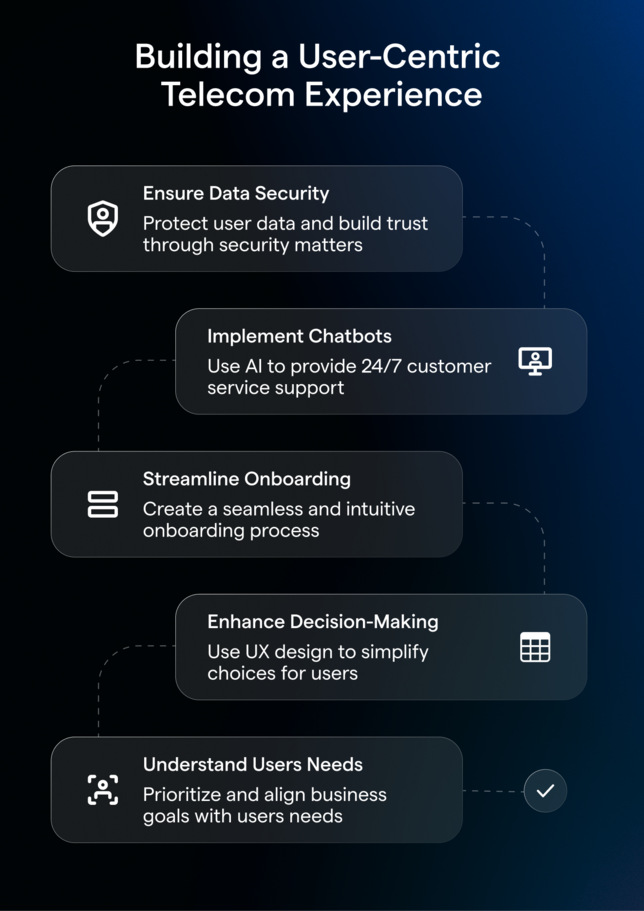
Kuba Danecki
-
Jan 20, 2025
-
9 min read
In this article, we will explore essential UX strategies that can help telecom companies stand out in a crowded market and build long-lasting relationships with their customers.
Understanding the industry
The telecom sector is uniquely complex, with its mix of technical services, diverse customer needs, and rapidly evolving technology. From mobile plans and internet services to IoT connectivity and 5G rollouts, the user experience must accommodate varying levels of technical understanding and diverse use cases. Also, as a telecom provider, you should focus on understanding your user's needs and preferences across all touchpoints. Understanding these nuances is critical to crafting UX solutions that resonate with users and address their pain points.
The importance of UX in the Telecom industry
Telecom services are often seen as utilities, but customer satisfaction hinges on their perceived ease and reliability. Poor UX can lead to churn, while great UX can foster loyalty and drive revenue growth – basically, as with every other industry in the world, the UX determines whether your platform will succeed.
Moreover, the telecom market is highly competitive, with numerous providers vying for customer attention. A superior user experience can be a key differentiator, helping companies stand out. Customers are more likely to choose and remain loyal to providers that offer seamless, intuitive experiences across their services and platforms.
Practical user experience (UX) can significantly benefit the telecom industry by simplifying interactions between customers and providers. By streamlining onboarding, billing, and customer support processes, companies can reduce the number of support tickets and calls they receive. This clarity not only enhances customer satisfaction but also improves operational efficiency.

Pick your strategy
Every process you initiate within your organisation should begin with a clear strategy. Start by understanding and prioritising your users' needs in this particular situation. Once you grasp those needs, define specific business goals that align with them. While emphasising user needs, it's essential not to overlook your business objectives. Instead, adjust those objectives to better fit user needs, achieving an optimal balance between the two.
To accomplish this effectively, you must first identify your target audience. Then, you can create user personas and map customer journeys. While this may initially seem overwhelming, we can help simplify the process. We recommend visiting our Digital 101 page, where we provide detailed insights, including information about customer journey mapping.
Create a smooth decision-making process
Here, you have to put yourself in your user's shoes. Imagine that you are about to choose a telecom provider for your personal use. The abundance of options can be overwhelming. How do you ensure that you, as a provider, will stand out to your users? The answer should be apparent at this point. It's a good UX design. It can simplify the choosing process for your users by providing comparison tools, filters, and personalised recommendations.
To assist your users better in making their decisions, clearly present your pricing, outline transparent terms, and ensure logical navigation on your platform to encourage them to choose you over competitors.
Ensure an intuitive onboarding experience
First impressions are everything – in the telecom industry, they often start with onboarding. A well-designed onboarding experience can create a positive, long-lasting relationship with your users. Start by simplifying account creation – make it quick, straightforward, and user-friendly. Use clear, concise language and avoid overwhelming users with unnecessary steps or information.
Once users are in, guide them through the platform with easy-to-follow tutorials or interactive walkthroughs demonstrating key features and benefits. Keep the instructions simple and engaging, ensuring users feel confident navigating your services.
Additionally, clear communication should be prioritised during this phase. Whether it's explaining billing options, service features, or technical setups, transparency and clarity can significantly reduce user frustration. Remember, the goal is to eliminate friction and provide a smooth, seamless experience that leaves a lasting impression. An intuitive onboarding process improves customer satisfaction and reduces the likelihood of early drop-offs, setting your platform up for long-term success.
If you want to explore the onboarding process further and learn how to design it effectively while avoiding common pitfalls, check out our article on the Digital101 page, which discusses onboarding in detail.
Consider chatbots for customer service
Artificial Intelligence is evolving rapidly and becoming increasingly advanced. While many people may fear these technologies, they can be leveraged to your advantage. One AI solution that can significantly benefit your organisation and make your employees' work easier is chatbots.
Customer service is critical in the telecommunications industry, as users often have questions or issues that require expert assistance. Since customer service is so important, it should ideally be available 24/7. One effective way to achieve this is by implementing specifically trained chatbots for your organisation and industry.
This solution can significantly reduce wait times, allowing customer service experts to focus on more complex inquiries. Therefore, we recommend implementing chatbots not to replace human jobs but to enhance the user experience (UX) and enable your experts to dedicate more time to demanding tasks.
Ensure high-security levels to increase trust
Security is crucial when users share sensitive data, especially in the telecom industry. It's essential to make users feel safe when providing their personal information. How can this be achieved? There are several options to ensure a secure user experience. For instance, implementing multi-factor authentication is one of the most recognised methods for securing users' data.
In addition to security measures, it's crucial to communicate privacy policies clearly. Demonstrating from the outset that your platform cares about users' privacy and security fosters a trustworthy environment. This approach encourages users to share their data and use your products without hesitation.
We encourage you to explore one of our case studies to help you better understand our approach to projects for clients in the telecom industry. In this case study, we detail the full scope of our work with Zain, a leading telecommunications provider in Kuwait.

Summary
Delivering an exceptional user experience in the telecom industry is essential, as it can truly set a company apart from its competitors. This involves simplifying the onboarding process and decision-making, utilising chatbots for assistance, and ensuring maximum security. Our aim is to create intuitive and seamless interactions that cater to users' needs. This focus is what we prioritise when starting new projects with our clients.
Our goal is always clear: to establish a new standard and unlock the digital potential of our clients’ products, regardless of the industry. If you’re looking for assistance with your platform, don’t hesitate to reach out and schedule a consultation with our experts.



















